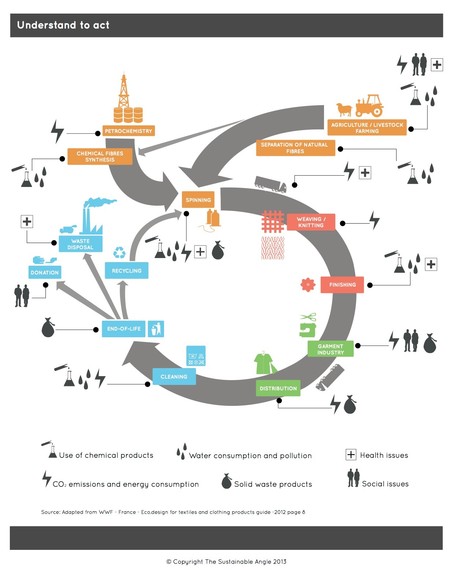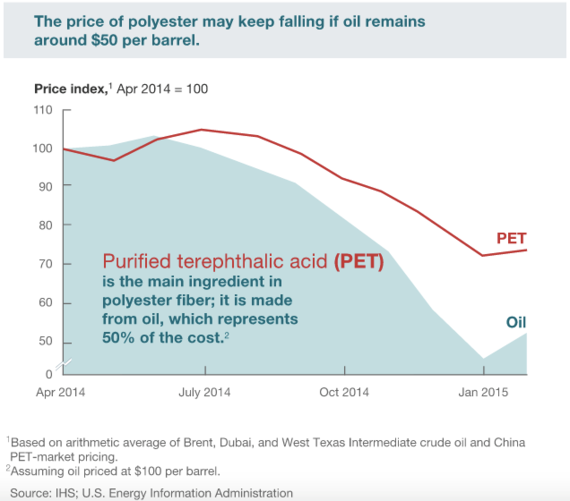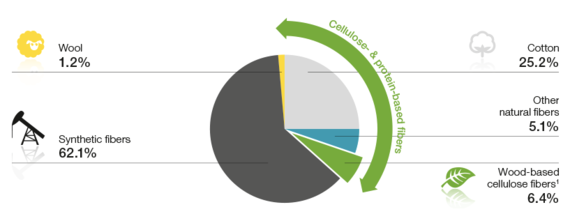Image: "Clothing Spill" by Savers. Credit: Ecouterre
Co-Authored by Kathrine Nasteva CEO Lozena
The reason I care about sustainable fashion isn't that my wife is the founder of the eco and ethical fashion brand Lozena (although that helps). No, the real reason I care is that fashion is one of the most polluting and energy-intensive industries in the world. From raw material acquisition, to textile production, to apparel manufacturing, to product disposal, fashion's environmental footprint is atrocious and it's time that changed.
Image: Fashion Products Lifecycle. Credit: The Sustainable Angle
We Wear Oil
One of the first and most disturbing things you learn about fashion is just how toxic the materials we wear are. That's because nearly one quarter of all chemicals produced worldwide are used in textiles. Worse, much of this comes in the form of polyester and other synthetic fibers which requires large amounts of crude oil. That's right, we literally wear oil.
Production of these fibers emits particulate matter and gases such as CO2, nitrous oxide (with a per kilogram global warming potential of 310 times more than that of carbon dioxide), hydrocarbons, sulfur oxides, and other by-products into the atmosphere. These processes also release volatile organic compounds and solvents in waterways from manufacturing plants. In short, wearing dirty oil may be the least of our worries.
Why is polyester so widely used in apparel production?
Polyester (polyethylene terephthalate), or PET has textile and industrial applications - it's a plastic, used as film for food packaging, electrical insulation, and water and soft drink bottles, among other things. Developed in 1941 in the UK most production now takes place in China - 33 million tons, or 65% of global production in 2015. The popularity of this fiber grew as a result of its stretch and shrink-resistant, low moisture absorption, and thermally stable properties. But it spread because it's really cheap. In 2014 one ton of conventional cotton cost $2,200 compared to $1,400 for one ton of polyester.
Although competition between conventional cotton, the most prevalent natural fiber, and polyester continues to fluctuate according to commodities prices, the production capacity of cotton plateaued and demand for polyester has surged since 1980. Production is forecast to grow to nearly 100 million tons by 2025, while at the same time its price is expected to fall in line with oil prices.
End of day commodity futures price for crude oil 9/13/16 closed at $44.90 USD per barrel. Image credit: McKinsey
It's not hard to see why apparel brands prefer polyester - it's inexpensive, blends well with other fibers, and new technological advances have dramatically improved qualities such as draping and denier, and enhanced performance features like breathability and sweat-wicking.
Why should you care?
The emergence and dominance of a fast fashion culture has resulted in skyrocketing demand for cheap, trendy clothing where frequent purchases are alluring and the disposal of heaps of barely-worn clothing is usually painless. While issues of environmental health and safety do not only apply to items made from synthetics (conventional cotton is a discussion for another time), the pervasiveness of these materials in our wardrobes has broader consequences. As of 2007, polyester became the most prevalent fiber used in apparel. This is a problem - not only because synthetic fibers aren't biodegradable and stockpile in landfills, but because the rise of synthetics is allowing consumer culture around fast fashion to proceed as "business as usual."
Inditex, the parent company of Zara, produces garments to the tune of 948 million per year - and that's just one company in an extremely fragmented and competitive industry. Low barriers allow for new entrants to the market at an incredible pace; and fast fashion brands introduce new trends every two weeks at ever-lower price points. The growth rate for women's apparel is expected to approach 5% per year by 2025, driven primarily by emerging market cities that will contribute an additional $100 billion to the market.
With 80% of the polyester manufactured used for textiles, MIT's Materials Systems Laboratory estimates that roughly 700 million tons of greenhouse gas can be attributed to fashion in 2015. That's because compared to a cotton t-shirt, a polyester t-shirt emits between 20-40% more greenhouse gases. All told polyester emits the equivalent of about 185 dirty coal plants - filthy stuff.

Image: Total impact of polyester used in the textile industry per year. Credit: MIT Materials Systems Laboratory
So what can be done when everyone in the world wants the newest styles - and they want them now?
Slow Fashion Gaining Speed
Now, more than ever before consumers are more conscience about the items that fill their closets. They're checking garment labels and purchasing high-value, lasting pieces. They're buying clothes that matter. Trends are disappearing as designers are attempting to be original and remain true to their aesthetic. And, more and more emerging brands, large corporations, and retailers are taking environmental and social issues seriously. While sustainable fashion still remains a niche market, the energy and environmental crisis doesn't have to start in your closet. For fashion, the future looks green.
Kathrine is the Co-Founder of LOZENA, a family-owned fashion house with a mission to produce designer womenswear in an ecological and socially responsible manner. Since launching, LOZENA fashion has been seen on the runways of Mercedes Benz Fashion Week Berlin; is featured in British Vogue and ELLE UK, and has been blogged about by numerous style writers. LOZENA is distributed exclusively via Kickstarter until October 8th, 2016.




